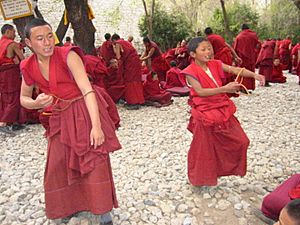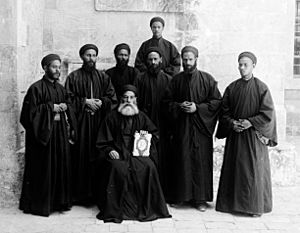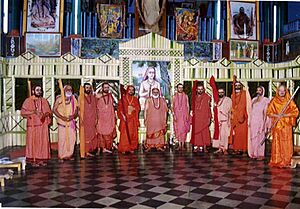Monasticism facts for kids
Monasticism, also called monachism or monkhood, is a religious way of life where people choose to focus entirely on spiritual work. They often give up worldly things and activities. This way of life is important in many Christian churches, like Catholic, Eastern Orthodox, and Anglican traditions. It's also found in other faiths such as Buddhism, Hinduism, and Jainism. However, some religions, like Islam and Zoroastrianism, generally don't practice monasticism. In modern Judaism, it plays a very small role.
Many monastics live in special communities called abbeys, convents, monasteries, or priories. They do this to separate themselves from everyday life. However, some groups, like mendicant (begging) or missionary orders, travel and live among people.
Contents
Buddhism
The Sangha, which is the community of Buddhist monks (called bhikkhus) and nuns (called bhikkhunīs), was started by Gautama Buddha over 2500 years ago. The word bhikkhu means 'beggar' or 'one who lives by alms'. This community way of life grew from earlier groups of wandering spiritual seekers.
At first, monks and nuns lived quite alone. They were expected to own very little. Lay followers (people who weren't monks or nuns) would freely give them food and shelter when needed.

After the Buddha passed away, the Buddhist monastic order became more communal. The Buddha had asked monks to live together during the rainy season. This practice slowly led to a settled monastic life focused on community living. Most of the rules for monks and nuns today, found in the Patimokkha, are about living and interacting in a community. The number of rules changes depending on the group. For example, Theravada monks follow about 227 rules. Nuns have even more rules.
The Buddhist monastic order includes both male and female groups. It started with only men, but later included women after the Buddha's stepmother, Mahaprajapati, asked for and received permission to become a nun.
Monks and nuns have several important roles. Their main job is to keep the Buddhist teachings and rules alive. They also serve as an example for lay followers. By supporting the monks, lay people can earn good karma. In return, monks and nuns are expected to live a simple life. They focus on studying Buddhist teachings, practicing meditation, and being good moral examples.
A person first becomes a novice (samanera). Novices can be quite young, usually no younger than eight. They follow Ten Precepts, which are basic rules. To become a full monk (bhikkhu), a man must be 20 or older. Nuns follow a similar path but usually stay as novices for a longer time, often five years.
The rules for monks and nuns are meant to create a simple and focused life. They are not meant to be extremely harsh. However, living without marriage or romantic relationships is a key part of this monastic life.
Christianity
Christian monasticism is where the words "monk" and "monastery" come from. It includes many different ways of religious living. It started early in the Church's history, but the Bible does not mention it. Its exact beginnings are not clear, but it seems to have started in places like Egypt and Syria. Over time, it became guided by religious rules, such as the Rule of St Basil or the Rule of St Benedict. Today, it is also guided by the laws of the Christian churches that have monastic groups.
Christian monks choose this life because they feel called by God. Their goal is to live like Christ as much as possible. They believe this prepares them for eternal life after death.
The names for monastics are different in various Christian groups. In Roman Catholicism and Anglicanism, monks are called Brother (or Father if they are also priests). Nuns are called Mother or Sister. In Eastern Orthodoxy, they are usually called Father or Mother. Women who live a monastic life are generally called nuns or religious sisters. Men are called monks, friars, or brothers.
During the 4th and 5th centuries, monasticism allowed women to choose a life devoted to God. This was different from traditional lives of marriage and raising children. Monasticism gave women a lot of spiritual freedom. Women also helped greatly in starting and funding the monastic movement. Monasteries were places for monks and nuns to live together. They had different levels of strictness for rules and punishments. These rules often came from the Desert Fathers. A superior (Father or Mother) managed these rules. Even though female monastic communities had different practices, they all focused on prayer, quiet thinking, and helping others.
Teachings from Shenoute of Atripe, an important person in Egyptian monasticism, were also used in monasteries. He wrote about monastic life, sometimes using male words. But his federation included both male and female groups.
Later, in 379 CE, the first monastery for women was founded in Jerusalem by Saint Melania the Elder. This was a big moment. Before this, female monasteries were only connected to male ones. However, women who lived a spiritual, simple life existed even before the earliest known female spiritual leaders, like Saint Mary of Egypt, who lived in the 5th century CE.
In 4th century Egypt, some Christians felt called to live a more secluded life, like hermits. They did this for spiritual renewal and to feel closer to God. Saint Anthony the Great is known as one of the first "Hermit monks." Living alone as a hermit remained common, especially in the Middle East, until Syriac Christianity declined in the late Middle Ages.
Around 318, Saint Pachomius began to organize his many followers into the first Christian communal monastery. Soon, similar communities were set up across the Egyptian desert and the eastern Roman Empire. Important monasteries in the East include:
- Monastery of Saint Anthony, one of the oldest Christian monasteries in the world.
- Mar Awgin founded a monastery in Mesopotamia (around 350). From there, communal monasticism spread to Persia, Armenia, Georgia, India, and China.
- St. Sabbas the Sanctified organized monks in the Judean Desert near Bethlehem (483). This monastery, now called Mar Saba, is seen as the mother of all Eastern Orthodox monasteries.
- Saint Catherine's Monastery was built between 527 and 565 in the Sinai Peninsula, Egypt, by Emperor Justinian I.
In the West, an important change happened when rules for monastic communities were written down. The Rule of St Basil is thought to be the first. The Rule of Saint Benedict, created by Benedict of Nursia for his monastery in Monte Cassino, Italy (around 529), became the most common rule throughout the Middle Ages and is still used today. The Augustinian Rule is shorter and has been adopted by various groups. Around the 12th century, mendicant orders like the Franciscans and Dominicans chose to live in city convents among people, instead of being hidden away in monasteries. St. Augustine's Monastery in Erfurt, Germany, founded in 1277, is seen by many as the "cradle of the Reformation." This is because Martin Luther lived there as a monk from 1505 to 1511.
Today, new forms of Christian monasticism are developing in various places. Many of these are ecumenical, meaning they include different Christian traditions. Examples include the Bose Monastic Community in Italy and the Taizé Community in France.
Hinduism
In Hinduism, some people choose a monastic path (Sannyasa) to reach their spiritual goals. Monastics commit to a life of simplicity, living without marriage or romantic relationships, and focusing on God. A Hindu monk is called a sanyāsī, sādhu, or swāmi. A nun is called a sanyāsini, sādhvi, or swāmini. These renunciates are highly respected in Hindu society. Their choice to give up selfish and worldly things inspires others. Some monastics live in monasteries, while others travel from place to place, trusting God to provide for them. It is considered a very good deed for a lay person to give food or other necessities to sadhus. Sadhus are expected to treat everyone with respect and kindness, whether rich or poor, good or bad. They are also expected to not care about praise, blame, pleasure, or pain. A sādhu can usually be recognized by their orange-colored clothes. Generally, Vaishnava monks shave their heads except for a small patch of hair, while Saivite monks let their hair and beard grow long.
A sādhu's vow usually means they cannot:
- Own personal things besides a bowl, a cup, two sets of clothes, and medical aids like glasses.
- Have any contact with women.
- Eat just for pleasure.
- Have or even touch money or valuable items.
- Keep personal relationships.
Islam
Islam generally does not allow monasticism. In Sunni Islam, there's a story about Uthman bin Maz'oon, a companion of Muhammad. He decided to spend all his time in night prayers and live without his wife. His wife was upset and spoke to Muhammad. Muhammad reminded Uthman that he, as the Prophet, also had a family life. He said Uthman had a duty to his family and should not choose monasticism as a religious practice.
Muhammad told his companions to make their lives easier and avoid being too extreme. He said: "Do not do that! Fast on some days and eat on others. Sleep part of the night, and stand in prayer another part. For your body has rights upon you, your eyes have a right upon you, your wife has a right upon you, your guest has a right upon you." Muhammad also said: "Moderation, moderation! For only with moderation will you succeed."
Monasticism is also mentioned in the Qur'an:
Then We caused Our messengers to follow in their footsteps; and We caused Isa(A.S.), son of Mariam, to follow, and gave him the Injil, and placed compassion and mercy in the hearts of those who followed him. But monasticism they invented – We ordained it not for them – only seeking Allah's pleasure, and they observed it not with right observance. So We give those of them who believe their reward, but many of them are evil-livers.
- —Qur'an Verse 27, Surah Al-Hadid (chapter 57)
However, there are some similarities between Muslim and monastic spiritual practices. First, the importance of obedience in monastic life is like the importance of surrender in Islam. Second, just as monastic communities pray several times a day, Muslims pray five times a day. Finally, the meditative reading of sacred texts in monasticism is similar to the Muslim belief that God speaks to each person through the Qur'an.
Islam encourages people to not focus only on worldly life, but it doesn't say believers must completely abandon it. This is called zuhd in Islam. Some Islamic teachings say that the only "monasticism" in Islam is Jihad, which means striving in the cause of Allah.
Jainism
In Jainism, monasticism is encouraged and respected. The rules for Jain monastics are quite strict. A Jain ascetic has no permanent home or possessions. They walk barefoot from place to place, except during the rainy season. Their life is difficult because of many restrictions. They do not use vehicles and always walk barefoot, no matter the distance. They own no material things and do not use basic services like phones or electricity. They do not prepare food and live only on what people offer them.
Judaism
Judaism does not encourage the monastic ideas of living without marriage or being poor. Instead, all of the Torah's commandments are meant to make the physical world holy. The teachings of the Yisrael Ba'al Shem Tov even encourage enjoying permitted physical pleasures as a way to "serve God with joy."
However, until the Second Temple was destroyed about two thousand years ago, taking Nazirite vows was common. Nazirite Jews did not drink grape products, cut their hair, or touch dead bodies. But they did not leave society. They were allowed to marry and own property. Also, most Nazirite vows were for a set time, not forever. In modern Hebrew, "Nazir" usually refers to non-Jewish monastics.
The Beta Israel community in Ethiopia is unique among Jewish groups for its monasticism, which is believed to date back to the 15th century.
Some Jewish people in pre-World War II European Ashkenazi communities practiced a form of simple living called prishut. This meant a married Talmud student would leave home and family to study in a different city. This practice was linked to, but not only for, the Perushim.
The Essenes were a Jewish group that existed from the 2nd century BC to 100 AD. Some scholars believe they separated from the Zadokite priests. The Essenes were fewer in number than the Pharisees and Sadducees (the other two main groups at the time). They lived in various cities but gathered in communities dedicated to simple living, choosing to be poor, daily ritual bathing, and avoiding worldly pleasures. Some groups even avoided marriage. Many similar religious groups from that time shared mystic, end-of-the-world, and simple living beliefs. These groups are sometimes called "Essenes." Josephus wrote that many Essenes lived throughout Roman Judaea.
The Essenes became famous recently because of the Dead Sea Scrolls. These religious documents are commonly thought to be the Essenes' library, though there is no proof. These documents include copies of the Hebrew Bible that were untouched from as early as 300 years before Christ until their discovery in 1946. However, some scholars disagree that the Essenes wrote the Dead Sea Scrolls. Rachel Elior, an Israeli scholar, even questions if the Essenes existed at all.
Sikhism
Sikhism teaches that it is better to be focused on God while living a normal family life than to be an ascetic. According to Sikhism, ascetics are not on the right path. When Guru Nanak visited Gorakhmata, he talked with some yogis about the true meaning of asceticism.
Asceticism doesn't lie in ascetic robes, or in walking staff, nor in the ashes. Asceticism doesn't lie in the earring, nor in the shaven head, nor blowing a conch. Asceticism lies in remaining pure amidst impurities. Asceticism doesn't lie in mere words; He is an ascetic who treats everyone alike. Asceticism doesn't lie in visiting burial places, It lies not in wandering about, nor in bathing at places of pilgrimage. Asceticism is to remain pure amidst impurities.
– Guru Nanak
Taoism
Over many centuries, Taoism, especially the Quanzhen School, has developed its own extensive monastic traditions. The White Cloud Monastery of Dragon Gate Taoism in Beijing is very well-known. It holds a rare complete copy of the Daozang, which is the main Taoist holy book.
Other Religions or Movements
- Ananda Marga has both monks and nuns. They work directly to help society and do not live in permanent retreat. They follow strict rules, including living without marriage and choosing to be poor.
- Bön is believed to have a rich monastic history. Bön monasteries exist today, where monks practice Bön-Buddhism.
- Manichaeism had two types of followers: auditors and elect. The elect lived separately from the auditors to focus on reducing worldly influences. They did this by living without marriage, choosing to be poor, teaching, and preaching. So, the elect were likely at least partly monastic.
- Scientology has a group called the Sea Organization (Sea Org). They work only for the Church of Scientology and have signed very long contracts. Sea Org members live together, and the Church provides their lodging, food, clothing, and medical care.
- Sikhism and the Baháʼí Faith both specifically forbid monasticism. Therefore, there are no Sikh or Baháʼí monk communities.
- The Quanzhen School of Taoism has monks and nuns.
- The Transcendental Meditation movement supports two monastic groups: the Thousand-Headed Purusha for men and the Mother Divine for women.
See also
- Asceticism
- Double monastery
- Guru
- Hermit
- Mendicant
- Religious order
- Sādhanā






